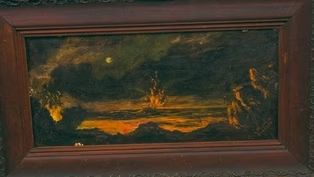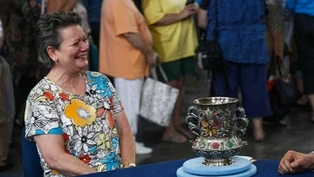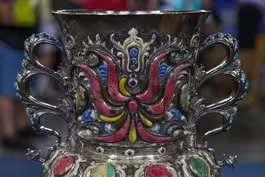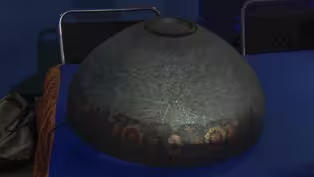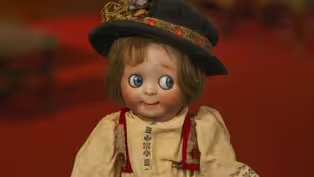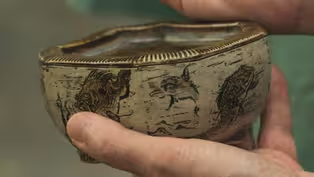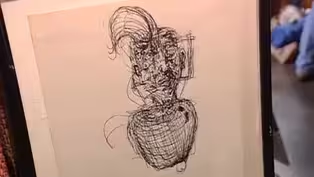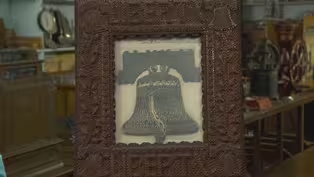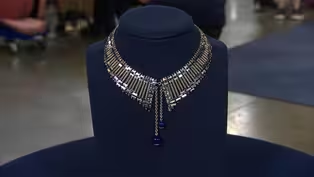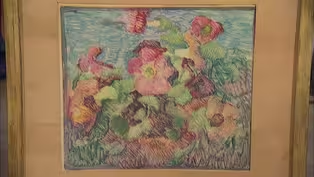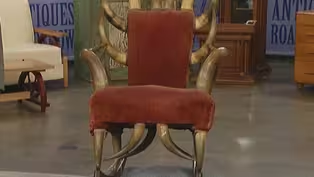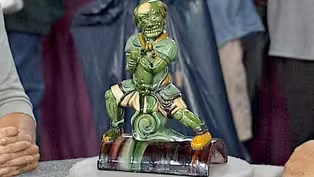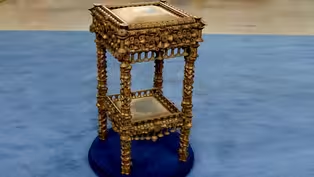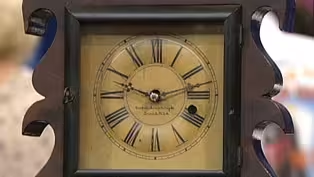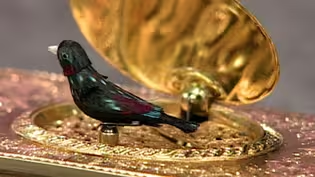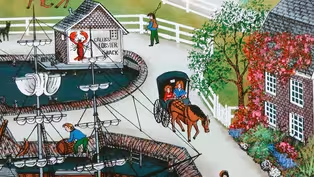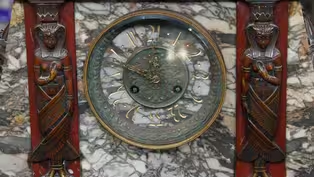
Pretty or Pretty Ugly?
Season 29 Episode 24 | 52m 24sVideo has Closed Captions
Is beauty in the eye of the beholder? Discover the value of these eye-popping treasures!
Is beauty in the eye of the beholder? Uncover the value of eye-popping ROADSHOW treasures including a 1982 George Condo drawing, a folk-art spool table, ca. 1900 and a Guido Gambone vase, ca. 1960. One item is a whopping $50,000-$100,000!
Problems playing video? | Closed Captioning Feedback
Problems playing video? | Closed Captioning Feedback
Funding for ANTIQUES ROADSHOW is provided by Ancestry and American Cruise Lines. Additional funding is provided by public television viewers.

Pretty or Pretty Ugly?
Season 29 Episode 24 | 52m 24sVideo has Closed Captions
Is beauty in the eye of the beholder? Uncover the value of eye-popping ROADSHOW treasures including a 1982 George Condo drawing, a folk-art spool table, ca. 1900 and a Guido Gambone vase, ca. 1960. One item is a whopping $50,000-$100,000!
Problems playing video? | Closed Captioning Feedback
How to Watch Antiques Roadshow
Antiques Roadshow is available to stream on pbs.org and the free PBS App, available on iPhone, Apple TV, Android TV, Android smartphones, Amazon Fire TV, Amazon Fire Tablet, Roku, Samsung Smart TV, and Vizio.
Buy Now

ANTIQUES ROADSHOW DETOURS
Ever wondered what happens to the treasures featured on America’s beloved ANTIQUES ROADSHOW after the cameras leave town? Host Adam Monahan tracks down the juicy afterlives of your favorite finds from PBS’s hit series.Providing Support for PBS.org
Learn Moreabout PBS online sponsorship♪ ♪ Ever since I saw this piece of jewelry, I thought it was the most beautiful thing, and my mother thinks it's ugly.
It is probably the ugliest thing I've seen on the "Roadshow."
(guest laughs) I mean, it's not really a pretty thing.
CORAL PEÑA: It's "Antiques Roadshow: Pretty or Pretty Ugly."
♪ ♪ PEÑA: As the saying goes, beauty is in the eye of the beholder, and that's always true when it comes to art, collectibles and antiques.
What you might think is tacky or unappealing might be highly desirable to someone else.
I think it's beautiful.
Right.
My husband thinks it's ugly, and he didn't want me to bring it today.
Oh... It's beautiful.
PEÑA: Regardless of differing opinions, we've got the sometimes ugly truth about some pretty interesting and valuable treasures-- take a look.
GUEST: I actually inherited it for my birthday last year from my Aunt Libby, and she got it from her Aunt Libby, and she's from Leesburg, and she's had it in her family for a long time.
And ever since I saw this piece of jewelry, I just thought it was the most beautiful thing.
And since my Aunt Libby doesn't have kids, for my birthday, she gave it to me.
So I was really excited.
(soft chuckle) When it was my great-aunt Libby's piece of jewelry, my mother used to like, comment on how much she hated it, because she thinks it's ugly.
The brown lines in it, she thinks it makes it look horrible.
And I'm like, but it's character.
I think it's character.
It's interesting-- it-it is opal, the center stone.
Opal comes in many forms, it comes from many places.
Sometimes it's more milky.
Then you have black opal, which-which is like this very dark with this fire in it.
And then out west, especially out here, you-you see what they call boulder opal.
And this is very reminiscent of boulder opal.
That tends to have more of these matrix lines in it... Mm-hmm.
...which is you're seeing there.
A long time ago, you had an appraisal on this, correct?
Yeah, it was done in 1978 by my great-aunt Libby, and it was for $2,500.
It is signed.
Oh, it is, oh, I did not know.
And right over here... ...it says Marcus and Company.
Now, Herman Marcus came to this country from Germany in 1850.
He was a very talented jeweler.
When he started here, he worked for multiple firms, but most notably, he worked for Tiffany and Company.
He left Tiffany and then worked for another big company called Theodore Starr, and it became Starr and Marcus.
That dissolved, guess where he went?
He went back to Tiffany (chuckles) After that, he started working with his sons.
Oh, really?
Oh, wow.
Right, and then the firm then became Marcus and Company.
Oh.
He made this beautiful Art Nouveau style jewelry.
And that's-that's the design you see.
Now he was very meticulous about his metalwork.
It's accented by old mine diamonds.
Oh, wow.
And then, you see, he had this use of this bright enamel in the background.
That's green enamel.
The enamels that work for him, a lot of them trained at Lalique, who was also known for making great enamel.
Oh, wow.
The ring up here, you wear it like this... Mm-hmm.
...with that ring on top.
Technically... it was designed... to be worn... ...like that.
Really?
Wow.
Something hang down.
Something like a freshwater pearl.
You have a piece that if you had to rewrite that insurance appraisal today, you would have to rewrite it for $12,000.
Oh, my goodness.
Wow.
It's-it's an important piece.
And Marcus jewelry, while it's always been good, more people are recognizing his genius.
Wow.
And I will save it for whoever's named Elizabeth in my next generation.
(laughs) GUEST: Because there's a tile and because it's a god I thought it was probably something it would go over a doorway in China.
Because he's so ugly, to maybe to keep away... (appraiser chuckles) ...keep away evil spirits.
Absolutely, well, you were very close.
Okay.
Yeah.
This is a Chinese glazed pottery roof tile, actually.
Roof tile, mm-hmm.
And let's look at how it's made here.
This wonderful curved base allows it to sit right on the roof.
Mm-hmm.
We can all picture the fabulous Chinese architecture... Mm-hmm.
Mm-hmm.
Mm-hmm.
...with pagoda roofs that end in that lovely curve.
Mm-hmm.
These tiles sit at the end of the curve along the edges of the roof line... Is that... ...and are decorated in fancier houses, temples and so forth... Mm-hmm.
Mm-hmm.
Mm-hmm.
...with wonderful figures like this one.
This particular one was made probably in the Ming Dynasty, around 1600 to 1700.
So it's really quite old.
Oh.
Oh, I'm surprised.
When you first brought it to the table, I thought, this can't really be a Ming one because it's in such lovely condition.
Mm-hmm.
Mm-hmm.
It doesn't look like it's been battered by the elements... Mm-hmm.
...but the colors of the glazes are just right.
The molding of the face and the details of the fingers and so forth.
Oh, I'm very surprised.
Yeah.
I thought it was even flawed because the green and this color is-- they're so close, I thought it might have been a mistake.
They are close-- no, I don't think so.
I think they actually intended to make this, the shawl around his shoulders... Mm-hmm.
...a lovely turquoise blue, which you see a lot of in the Ming tile work.
Oh.
Often, there's a lot more yellow in these figures.
This one is particularly dark with the green and the brown.
Yeah.
Yeah.
Now, you found it where?
You were looking for...?
I was at an ant-- at an antique market at Aberfoyle, Ontario.
Uh, 1966.
Uh-huh.
And-- Did you-- were you looking for Asian art or you just happened to...?
No, I just happened to catch my eye.
And do you remember what you paid for it?
Uh, under $100, probably around $65 Wow.
or $75.
Okay, that's fabulous.
Yeah.
Well, these don't bring immense fortunes at all, because there were, of course, even in the Ming dynasty, many, many of them.
Uh-huh.
There are many roofs in China... Uh-huh.
Uh-huh.
...and many roof tiles, but a lovely one like this would probably bring, at auction, today around $1,000.
Oh, isn't that great?
Oh, yeah.
So I think you've made a very good buy, and I think you have a great thing.
GUEST: A friend of mine bought it online five or six years ago.
APPRAISER: Uh-huh.
He didn't really care for it, and he finally just said, "Here, you can have this.
It's ugly.
I don't really want it."
Well.
So he gave it to me.
It's not ugly-- it's unusual, and it's wonderful.
And contemporary art is really hot right now.
It's by an American artist named George Condo, who was born in 1957 and then went to New York in the '80s and was part of that whole wonderful New York scene around that time.
He was friends with, uh, Andy Warhol's Factory... folks, uh, and also collaborated with William Burroughs, the writer, and also with Allen Ginsberg.
His style is called figurative abstraction, which is an unusual, contemporary surrealist style, which I think we can really see in this drawing.
This is a very special little piece.
Cool.
Uh, the back of it has a, um, art gallery label, so we have a nice documentation of where it's been.
I'd value this piece at between $1,500 and $3,000.
Wow!
(both laugh) Cool!
Wow!
(laughs) Oh, that's amazing.
GUEST: I know that it came from my paternal grandfather's side of the family, and I always thought it was this old, ugly vase.
Why would you put that out?
That is so ugly.
And my girlfriend had tickets to come to the show and invited me, and I thought, I'm going to take that old, ugly vase.
Okay, well, let me tell you a little bit about it.
Your vase is Japanese, and it dates from the first quarter of the 20th century, and it is part of a group of Japanese ceramics that are referred to as coralene.
And you can see the flowers are built up with little beads of glass.
There is a mark here.
It says U.S.
patent office.
U.S.
patent, yeah.
That's so it could be imported into this country.
Oh, okay.
The value is probably in the $800 to $1,000 range.
Okay.
And the question is, is this still an ugly old vase?
No, it's not.
I think it's gonna have a prominent place in my home now.
It's gotten prettier in the last five minutes.
(laughs) It has.
I don't think my mother's getting it back.
Well, um, I bought it in 1940 at an antique shop.
My mother said, "What on earth do you want with that ugly thing?"
She said, "It's not even comfortable."
You've got a cross between Adirondack, the very natural-looking carved wood, as well as mission style, also known as Arts and Crafts.
Probably made in Michigan.
Valuation on it, I would probably say in the neighborhood of $1,200 to $1,500.
Great chair for a great person.
Yeah.
(chuckling) Well, thank you.
GUEST: I've sort of inherited it from my grandfather, who was a collector for 35 years.
He probably acquired this clock sometime in the early '60s.
APPRAISER: This is called the wall model acorn clock.
And there were several models that the J.C.
Brown Company made of this acorn clock.
They were all made, I think, in the 1840s and '50s.
And this one, I have always felt was the rarest one.
Also, it was probably the one that was made the latest.
The mantle acorn clocks were the earlier ones, and they look quite different.
When I first saw one of these acorn clocks as a young collector, I said, "That is the ugliest thing I've ever seen in my life."
But since then, I-I think there's a haunting beauty about these things.
When these clocks were made in the 1830s, '40s and '50s, they were very bold designed for someone who was going to manufacture these clocks and try to sell them to an American audience.
What an unusual design.
Peter, when I first saw this clock, I thought that the veneer on this door had been, uh, removed and replaced.
But looking at it further, I don't think so.
It has a, a laminate on it of some sort, which is ebonized, and I believe that's original.
One of the most interesting features of this clock is the label.
It's got the original J.C.
Brown label, uh, who worked in Bristol, Connecticut, only about a half an hour's drive from where we are now.
And the reverse painting does show some restorations here on the back where it's been in painted.
The surfaces on the side have been varnished in an unattractive way.
But, uh, that's the only real restoration I see to this clock.
When we open the door to this, this is what I found inside, a note that says, "rare, $2,500."
And I say, well, where did this come from?
And you told me... That was my grandfather's estimate of its value several years ago.
Well, it's very rare.
Its condition is good.
It's about $12,000, $13,000 when you consider its greatly unrealized and undiscovered American antique.
I was fascinated when you came through the line this morning and said that this was something that, as a child, you saw... (chuckles) ...in a guest bedroom... Mm-hmm.
...and thought, "This is a really weird thing."
Very ugly.
Very depressing.
Yeah.
(both laugh) So tell me a little bit about what you thought as a kid looking at... I just-- it was always there, and I grew up with it, and I just thought it was very strange.
Very depressing.
Yeah.
Um, my friends spent the night with me in the bedroom, and they always thought it was very-- I kind of wish my parents would get rid of it, it was very embarrassing.
Yeah.
Yeah.
And then as an adult, I got interested in needlework... Yes.
...and I began to look at it carefully and say, "This is really impressive."
"This is really interesting."
It's a piece that was made in actually, Hadley, Massachusetts.
Oh, really?
Yes.
At a particular school called the Abbey Wright School in South Hadley, Massachusetts, in the early 19th century.
The way that we can tell that is that it has this very characteristic, sometimes gold, in this case, silver thread that's coiled around to embellish those urns.
And as I said, it was probably made... Mm-hmm.
...in the early decades of the 19th century by a very diligent little girl.
You think a little girl?
Uh, in-in your family... Mm-hmm.
...uh, whose picture, I think, is there.
Yes.
(laughs) And she was, uh, considerably... (laughing): 75.
Yeah.
Yeah.
Um, and this also teaches us a lot about American history, because it's not really that morbid.
Really?
(laughs) Uh, it was the kind of mourning picture that was done in the years immediately following George Washington's death, when it was a fashion for mourning art.
He died in 1799.
And this was made in the first decades of the, of the 19th century as part of that, kind of, fashion.
And, uh, you can see that these are blank, so that there was no particular relative that this was done for and made in the most beautiful materials with fugitive dyes, vegetable dyes that have flown away.
And these were the kinds of things that families, as they moved west, kept with them.
Mm-hmm.
So the fact that it has shown up here in San Diego... (chuckling): Yes.
...is another aspect of American history.
Uh-huh.
So it's a really wonderful, wonderful piece.
And sometimes they would have put, uh, names in those?
Yeah.
If there had been a convenient relative who had died, they would have been... Cause I looked up-- ...memorialized in that.
I looked up her-her husband and he died after her.
And I thought... Right.
...is this the sort of thing you... This was just something that was made.
So you didn't kind of do it in anticipation?
No, necessari-- not necessarily, but there is an interested market for this.
And if this were to come to auction, I would guess that it would bring somewhere in the vicinity of $4,500 or $5,000.
Wow!
(laughs) So.
A friend-- the reason I brought it was that a person who knew something about antiques was looking through our house and said, "This is very interesting."
Yeah.
And so I thought, "Well, okay."
It is.
Yeah.
And I'm delighted to see it.
Great, well, thank you very much.
Yeah, thank you.
APPRAISER: Who does this belong to?
GUEST: Belongs to my mother.
She said that it was special and that it was English.
Well, I agree on both things.
(chuckles) Did she say anything about why it's special?
She said it was two potter people that specialized in painting really ugly fish.
Well, there were brothers who worked in a part of London called Southall.
Southall is a, is a part of London that has a long tradition of making stoneware, which is what this is made of.
And they worked in the late 19th century and into the early 20th, and they were called the Martin Brothers.
And, yeah, they were weird, they were, I mean, you look up weird, and you get a picture of them.
Oh, that's great.
You can see the decoration.
It wasn't just fish.
They liked all kinds of, what I would call beasties, you know?
(soft chuckle) But they're definitely weird, every one of them.
And why would you put fish, in any event, on a sugar bowl?
Which I think is what it is.
It's worth about $1,000 at auction and possibly as much as $1,400 or $1,500 at auction.
Oh, my gosh.
Yeah, great thing.
Amazing!
Does your mum have other weird stuff?
(laughing) (laughing): She does.
Well, look around, if she has any other Martin Brothers.
I will.
GUEST: I brought a picture that has been in my family as long as I can remember.
I saw it hanging on the wall as I was growing up.
Thought it was rather ugly... big.
Mm-hmm.
And after my mother passed away, I wrapped it up and put it underneath my bed.
And that's where it's been until today.
My great-grandfather is in the photograph down in the bottom.
Well, when you pulled this, um, out of your-your cart... Mm-hmm.
...I first saw the frame.
And it's a wonderful tramp art frame.
It's made of wood.
And then I saw the photograph.
Right.
The photograph, as we can see, is the Philadelphia Liberty Bell, complete with crack.
And this was done by a pair of commercial photographers from Chicago, Arthur Mole and John Thomas.
And they became famous during the First World War with these living photographs.
Really?
That took thousands of troops to create these images.
They did the Statue of Liberty... Oh my.
...the head of, um, Woodrow Wilson, eagles, all sorts of things.
This was one of their most famous images.
Really?
And it's copyrighted 1918.
The partner, Mole, would stand up on an elevated place, just bellowing down to the group below to get it orchestrated, get it organized and-and photographed.
Wonderful.
This happened to be taken at Camp, um, Dix in-in New Jersey.
The print itself is in excellent condition.
The frame was made in 1921 by William Bergstrom, who must have been the... hired hand.
Hired hand.
And he so carefully made a frame that perfectly... Amazing.
...reflects the photograph.
You've got two great things-- to insure this piece, I would put maybe $8,000 on it.
Well, that's wonderful.
Something like that.
♪ ♪ My friend, uh, bought me this at an antique shop.
He thought I'd like it.
I do like it.
I love it.
It's green and ugly enough to be cool.
It's a 20th century piece that's made to look old.
Okay.
GUEST: This is made out of my relative's hair by my grandmother's grandmother.
And, uh, ever since I was five or six years old, I was just fascinated by it.
And I'm the only one in the family that is.
It represents an enormous amount of skill.
Something that was done during the Victorian period where people saved their hair and either made jewelry out of it or did these family hair wreaths that were sort of a memorial.
Any idea what this is worth?
It's not worth anything, according to my wife and daughter.
(laughs) That's why it sits in a closet and it's not displayed.
When I first saw this, I got a real thrill, because when I see boxes like this, um, you know what the first word that comes to my mind is?
Fabergé.
Now we should open this up.
Because when I opened it up initially, I was slightly disappointed because I didn't see Fabergé, but I did see something else.
You can tell me where you got this box.
I bought it from a dealer in Florida.
Mm-hmm.
At the time, he had three of these and he wanted to keep two of them and didn't like this one.
He thought it was kind of ugly.
Well, it's a very interesting lid.
We can take the box out... Put it on the table.
And this is what we call, when we set it off, a... (twittering) ...singing bird box.
(twittering) Now, this is a kind of music box that was made in Switzerland.
But what's interesting about this is the outer box that it comes in and that says "Hammer Galleries."
And that refers to the famous American industrialist Armand Hammer, who was amongst the first people to bring treasures out of Russia after the Russian Revolution.
Now, what's very interesting about this is the-the lid that you mentioned.
It's a rather wild looking character.
Yes.
And if I let my imagination go wild, I'd say that's probably Rasputin.
Maybe.
But that lid didn't start life on that box.
It has absolutely nothing to do with it.
Probably when this box was new, it had a bouquet of flowers, a scene of Geneva, something like that.
It's enamel; it probably got broken and it was replaced with a Russian character and it was sold as a czarist treasure.
Now don't look so disappointed at me right now because even so, the box like this is still quite a valuable object.
And even with the lid the way it is, and this was probably done 75, 80 years ago, it's probably still a $10,000 to $15,000 box.
Still, quite special and quite a wonderful object.
And I'm really delighted that you brought it here.
Well, thank you.
Thank you.
GUEST: Uh, it actually belonged to my father-in-law.
Um, he was in the boys choir at the Washington National Cathedral.
And when his voice changed, he worked on the custodial crew at the cathedral to help pay his tuition.
And he said he found this lamp in the trash being disposed of, and he rescued it; uh, when he passed away, no one in the family wanted Dad's ugly lamp, and my mother-in-law was going to call someone to pick it up for scrap metal.
I asked her not to do that, to let me look it over.
When I saw that it was marked Samuel Yellin, I did a little bit of research and my husband and I visited the Washington National Cathedral to kind of learn a little bit more about Yellin.
And we were shocked to find what appears to be an identical lamp hanging on the wall of the Chapel of the Resurrection.
When my father-in-law had it displayed in his home, he had that shade on it.
I don't know if it was original to the lamp or something that he created to go with it, but that's how we got it.
Well, I tell you what, it has nothing to do with it whatsoever.
(laughs) I think it was just a nice decorative shade that fit well.
Uh, but no, it has nothing to do with the piece at all.
Okay.
I love the story, and what's really wonderful about this piece is this, the mark on it of Samuel Yellin is so very clear.
And Samuel Yellin was a metal worker based in Philadelphia.
He started his business in around 1907, and at the peak of the business had over 200 people working for him, providing, uh, metalwork and lighting for great American homes.
Also national monuments; the Washington Cathedral.
Uh, from my little research I could do, he continued to supply pieces for the National Cathedral throughout a period of time.
What's lovely about the piece is that we're here at Winterthur today, and there are actually drawings in the museum collection of Samuel Yellin's work.
Really?
Yes, so really wonderful to see this here.
This is a single light fixture, and it's more ecclesiastical in design, so the value's, uh, a little on the softer side for his pieces.
But if I were to see this come up for auction, I would expect to see an estimate of around about $3,000 to $4,000.
That's fantastic.
That's an expensive piece of scrap metal.
(laughs) My grandpa was kind of a wheeler dealer, and he liked to go out and make a deal and barter and trade, and this was something he came home with.
One of many unique items that he came home with.
When you got it, were you just-- did you like it?
What, what'd you think?
Not at all.
When we were cleaning out the house that I-I got it from, I was on the verge of giving it to Goodwill or Salvation Army, and my husband said, "Let's take it home and take a little bit closer look at it."
Okay.
It was one of those things that was kind of always in my family, kind of always hanging out in the background that I never really liked.
(laughs) I actually thought it was kind of an ugly vase.
Okay, that's fair.
So... (chuckles) So it is now in my home, and I'm just curious what the value of it is.
Okay.
On the bottom, there's a marking.
And we did go online and find out that Guido "Gam-bone," I think, is how you say his last name.
"Gam-bo-nee."
Uh-huh.
Mm-hmm, was the maker of the vase, and it was made in Italy.
Let's take a look at that mark on the bottom.
Okay.
On the bottom, there's a donkey.
(chuckling): Yes.
And below that it says "Gambone."
Yes.
And then below that it says "Italy."
Guido Gambone... Yes.
...lived from 1909 to 1969.
Right.
And his pottery company in Italy, after World War II, they made some really interesting things in the 1950s and 1960s.
This particular vase would probably date from the 1950s or 1960s before Guido died.
And the mark with the donkey on the bottom is usually associated with him.
Now his son continued on after him... Yes.
...and then the mark changed.
His son Bruno.
And the mark changed, but usually this mark is associated with the father.
Right.
Now, he did a lot of stuff with figures on it, with people, animals, and kind of almost looked a little like Picasso or something sometimes.
Abstract.
Yeah.
Mm-hmm.
Abstract, and then this one is just geometric.
Yes.
And if you look at it, it's a little lopsided.
(laughs) And this was not actually made on a wheel, but this was actually coil-made.
Okay.
So there would be a coil of pottery.
And you can see that by looking on the interior... Okay.
...that this long coil of pottery was made and-and then put round and round and round and then smoothed off.
Okay.
I see.
And then they added this really rich, rough, bubbly glaze... Yes.
...which is really kind of wonderful.
The shine, yes.
Yeah.
Gambone pottery was actually sold in the United States.
Okay.
So it was exported here, it was fairly expensive.
Mm-hmm.
Several of us appraisers, we all looked at this Sure.
...and none of us have ever seen a piece of Gambone this big.
R-- okay.
So it's remarkable in its size.
I would believe that a retail price would be somewhere between $7,000 and $10,000.
(laughing): Oh, okay.
Oh, my gosh.
Okay!
So if you had given it away to Goodwill... (laughs) So I have my husband to thank for that.
Yeah, if it weren't for him, we wouldn't be here today.
So this was the piece that brought us to "Antiques Roadshow."
My great-grandmother brought it over from Czechoslovakia and gave it to her daughter, and when my dad was born, she gave it to my father, 'cause he was a boy and it's a boy doll.
(chuckling): We named him Hunzi-Czech, 'cause he's from Cz... Hunzi-Czech.
'Cause he's from Czechoslovakia.
My daughters think he's creepy.
(laughing) (chuckling): Oh, those silly daughters.
But I, I think he's cute.
What are we going to do with them?
(both laughing) So, he's all hand-strung.
Um, his eyes move.
Okay.
I mean, he's, he's... He's a family member.
(chuckles) He is one of your family members.
That's what I like to hear.
Your doll is actually from Germany.
Oh, is it?
And then maybe sold in Czechoslovakia as a, a souvenir doll.
He was originally made about 1910.
Ooh.
And what we really love about him is that he was made by Kestner, and he's mold 221.
And Kestner was a self- proclaimed king of doll makers, and he kind of used that to market his dolls, but he ended up really being the king of them.
He sold and made a lot of dolls.
And your doll has a, a bisque head and a composition body.
And his eyes are made of glass.
It's mouth-blown glass, and they're what we call googly eyes.
His costume was probably made in Czechoslovakia, 'cause it is... Well, that's where my grandparents were from, is Czechoslovakia.
Mm-hmm.
And then he does have on his original mohair wig and his little wool felted hat with silk flowers and beautiful embroidered ribbon.
And then the other thing we s-- talk about with this doll is their grin.
Just a big, like, "I am so happy, but I'm, also might be up to a little bit of something."
His bisque head is in excellent condition, and that's where the value is.
But we've got a little damage to our toes, and that's just because it is composition.
It's just a wood product, and that's really easy, to break fingers and toes.
And we're really lucky, 'cause he has all his fingers.
It's just, we do have that toe damage.
And then he also needs a little restringing.
Mm-hmm.
Because you can see, his arms just... Normally, you could actually hold their arms up, because that's how I like to pose 'em.
I like to pose 'em with the arms standing straight up, like, "Ta-da, here I am."
(chuckles) "Ready to start trouble."
These dolls are actually pretty hard to find.
In today's market, his retail value-- with the damage-- would be somewhere between $4,500 and $6,500.
Hm!
That's great.
(chuckles) Y, you move out of the box.
(laughing) Uh, unfortunately, in the '70s, my father was cleaning out the attic and threw out the base, because he thought it was ugly.
And when he passed away, it became mine.
Handel was a company in Meriden, Connecticut, made this sort of lamp early part of the 20th century, they-- but they started in the late 19th century.
Um, I think the good news is that the shade alone is probably a $4,000 to $6,000 shade, but if you had the base, probably it'd be double that.
Wow, okay.
So, $8,000 to 12,000 for the lamp.
Oh, my goodness.
It's kind of a shame, but we don't know how elaborate or how good the base was.
I brought a... b-- a gold liqueur ballerina Bols music box.
It's, uh,... belonged to my first wife; she passed away several years ago.
I don't know a whole lot about it, but I always thought it was really just the coolest thing.
PRODUCER: Have you tasted the liquor?
Oh, no, no, no, no.
You don't want to open it!
GUEST: It's made with washers and screws and bolts, and it looks more like an engineering piece than a jewelry piece to me.
It was my mother's... APPRAISER: Mm-hmm.
...and we don't know if she purchased it before she came from Europe in 1940, or if a friend of hers, who traveled extensively, brought it to her.
This is a piece of German jewelry.
We can date it specifically to 1931.
It's made by a company called Jakob Bengel.
He opened the company in the 1870s.
He was a locksmith and started a company to make watch chains.
Hm.
And now they're in the jewelry business.
And by the early '20s, they're being influenced by the Bauhaus school.
The German Bauhaus is a movement that's combining Arts and Crafts and Art Deco; it's a structural design.
This is machine age.
The material it's made out of is chrome-plated brass.
Oh.
And it drops two pendants of glass that are to look like lapis lazuli, and, uh, it's enameled.
It's a pretty elaborate example of a brick link form.
This piece, if it were to come to auction, would probably take an estimate of $900 to $1,200.
We'll have to learn to appreciate it more.
(chuckles) Thank you!
GUEST: I bought it in an antique mall on Lincoln Avenue in Chicago in 1990.
The dealer told me that he purchased it in a barn in, uh, southern Wisconsin, and-and I believed him, because I literally picked pieces of hay off of it after I purchased it, so.
APPRAISER: I was immediately drawn to this.
And, after thinking about it, a lot of people consider tramp art and things like this the ugly ducklings of folk art.
(chuckles) It's easy to love something that's very refined and finely made, but there's also a group of us out there that love things with personality and funk.
This is funky.
Yeah, this has personality, it's true.
So, I like things like this, and this is a really elaborate one, so.
Yeah, I mean, they did these nice little rosettes right there in the center of the first skirt, or the first drop.
And then down at the bottom, they did those tapered spools to give that a V effect.
And it's a perfect example of what somebody does with their imagination.
It's made out of found objects.
Right.
And it's whatever the man or woman that made this came up with.
The other thing that struck me was... that this has, what I would call, a ragged patina, from putting it in the barn.
Mm-hmm.
That's what happens.
Think about this-- when this was made new, It had this bright gold paint... Right.
...and these panels, these cloth panels, were very bright.
Right.
So, I'll bet you, the first time it went in somebody's house, it would be like, "Whoa!"
You walk by it and it would just bowl you over.
And now it does the same thing, I think, with the subtleties.
We could wax poetic and get all intellectual about the shadows and the negative space... (laughs) ...and all that kind of stuff, but it goes back to a very simple thing.
It's something that he saw in his head-- he or she.
And it's just something that was executed really well, that gives us sort of a, a visual delight.
So, you bought it in when?
1990.
Okay, what did you pay for it then?
$175.
That was a pretty good investment.
I hope so.
Well, I talked to my colleagues over at the folk art table and the furniture table, and we were thinking for an insurance value in today's market, we would do somewhere between $1,000 and $1,500.
Well, that's great news.
GUEST: I went to a farm auction about five or six years ago, about 20 or 30 miles west of Minneapolis here.
They were in a box, two together, and I bid on them.
And I started the bidding at a dollar, and somebody bid three or four of them-- anyway, I wound up getting them for five dollars.
Five dollars for both of them?
For the both of them, yeah.
And did you, uh, know anything about them when you bought them?
No, I did not-- I just like the looks of that one particular.
I thought this one was kind of ugly, but... (laughs) So I got them and took them home, and I-I hung that one in my living room... Right.
...for quite a while, and I hung this one in the family room.
And, uh... I've just enjoyed them since I had them.
The painting on the top is by an artist named Spencer.
It's signed in the lower left, and it's actually a painting that was done more recently, certainly in the latter half of the 20th century, and probably by an artist who is a bit more commercial and painting for more decorative reasons.
We put a value of around $100 to $200 on that... Yeah.
...if you were to find it in an antique shop.
Now, the second painting-- were you able to read the signature on this?
I couldn't see the name, so I couldn't look it up.
Well, here we have the signature in the lower right.
And the name of the artist is Victor Higgins.
Victor Higgins grew up on a farm in Shelbyville, Indiana.
Okay.
He was born in 1884, died in 1949.
Oh, you know all about this.
Well, he's-- he's a well-known artist.
Really.
He's actually a member of what's called the Taos Society of Artists.
Hm.
Now, when you bought this, did you think this looked like a particular area?
I go to Arizona in the wintertime, and I thought it looked like, uh, down in Arizona and New Mexico, down in that area.
Well, you're absolutely right.
He moved there permanently from Chicago around 1915, and he remained there till the end of his life.
Mm.
He was well-known for painting pueblos and, uh, the life of the Native American, as well as landscapes like you see here.
His style started out in a more impressionistic manner, but by the time this was painted, he became a little bit more of a modernist.
You see some of the hard edge lines and the forms that denote modernism as opposed to Impressionism.
Now, the date of this painting... is not exactly known.
However, the painting itself is on Masonite.
Mm-hmm.
And Masonite was not really in use until after 1926.
Mm.
So we can say that this was done after 1926.
Is that oil or acrylic?
That's oil.
Okay.
And... you can see that it has sort of a yellow cast over the surface.
It's very dirty.
Does it need... Does it need cleaning, that's what I... It needs cleaning.
Right up at the edge, you can see there's a little bit lighter blue.
Uh-huh.
And if it were cleaned, it would-- that sky would actually be a bright blue.
But it should be cleaned by somebody who knows really what they're doing, not me, right?
Yes, right.
Yes, that's right.
(chuckles) And the-the cost of cleaning something like this would not be very expensive, because it's otherwise in excellent condition.
The frame is original; it's very typical of what he would use.
And you can see it's a, a painted frame, as opposed to gold leaf.
If this were for sale, in an art gallery in Santa Fe, for example, which is where he probably would sell best.
I think it would sell in the range of $75,000.
Whew!
You blew me away!
$75,000?
Yes, yes.
I don't believe it.
(laughs) Well, if it were cleaned, it could even be up-- closer to 100, depending on how it cleaned up.
Wow.
That's quite a find.
Terrific.
$75,000.
Yeah, it's, it's wonderful.
Unbelievable.
GUEST: It was a violin that my Aunt Vivian had used.
We know it's really old.
It was inherited by my immediate family about 30 years ago, and frankly, it's been sitting in a-- in a closet over the last 30 years.
So, your family believes that it's, uh, actually from the 16th century, because it's got a label that says "Gaspar Tieffenbrucker, 1519," And it's something that your great aunt played in recital.
Yes.
And-and it's been in... She was quite a musician.
...and it's been in your family all this time.
This is a very unusual style, because it has, instead of a spiral scroll, it has the carved man's head.
Mm-hmm.
Some people believe that to be the head of the maker, Gaspar Tieffenbrucker.
But you can see that the carving on this example is quite fine, especially the detail in the beard... Mm-hmm.
...and the eyes, and all of the facial features, his hooked nose.
There is actually an etching that exists of Gaspar Tieffenbrucker that this is taken from.
As we head down towards the bottom of the instrument, we see a beautifully inlaid flamed maple fingerboard.
Coming down the face of the violin, we see various relief-carved motifs.
On the sides, we see wood, inlaid... to look like an old city scene.
Mm-hmm.
As we go to the back of the instrument, this is where it gets really spectacular.
We have three types of decoration: we have the relief carving at the top, we have an oil painting, and... all of this intricate inlaid wood that shows a scene of an ancient city.
It's not actually from the 16th century.
It's a French instrument that was made in the 1800s, probably by the shop of Derazey in Mirecourt, France.
Mm-hmm.
But it was done very, very beautifully, and it was done true to style.
Uh-huh.
Now, your aunt had an outfit here-- she's got a case and a bow.
Let's look at the bow.
It looks rather plain.
Mm-hmm.
It looks a little bit, uh, like it hasn't been used in quite a while.
The hair is broken on it.
Mm-hmm.
As we take it out, we see that it's actually a very fine bow.
In its simplicity, it's got a certain elegance.
This bow was actually made in probably the late 1940s, in the shop of Eugène Sartory in Paris.
It has a mother-of-pearl inlay in the eye of the frog, and it's got beautiful sterling silver fittings.
Mm-hmm.
It's got a beautifully carved head up here... Mm-hmm.
And that was all done by hand, done by knife work.
This bow by Eugène Sartory is a classic example of one of the most innovative makers of the 20th century.
As I turn it around, you can see his stamp on the shaft of the bow.
The value of your violin is between $3,000 and $4,000.
Uh-huh.
The value of this bow, although it was purchased to accompany the violin, probably for $100 or so, is worth, at a retail violin shop, $14,000 to $15,000 today.
(laughing): Holy smokes!
When was the bow made?
Late 1940s.
No kidding.
Wow... GUEST: I got it at an estate sale.
I paid something under $50.
APPRAISER: Oh, wow!
My husband thinks it's ugly, and... Oh!
he didn't even want me to bring it today.
It's beautiful, though.
I think it's beautiful.
It was born as a vase... Oh, okay.
...in Japan.
Oh, in Japan.
In early 20th century.
Wonderful.
If it didn't have a hole, it could have been much more value.
We have decided that it's really, really ugly, but it might be worth something.
So, it's either gothic, real gothic... sort of gothic, or just plain ugly.
It's been part of our family for a lot of years, and people always made fun of it, because it was so ugly, and we would rub its belly for good luck and take it to bingo games for luck.
(laughs) My wife doesn't care for it too much.
You brought this piece, and there was a-- sort of a controlled gasp at this table, up and down, Because it so looks like a piece of English Martin Brothers.
And so, I looked at it, and I flipped it... And I see this mark, which is a French mark.
"Sarreguemines."
Sarreguemines is not only one of the largest French potteries, but it's one of the biggest potteries ever.
I believe they had up to 3,000 employees.
They did everything, every type of pottery, and they did lots and lots of copies of other people's stuff.
So, I have never seen a piece of Sarreguemines... that imitated so well a piece of Martin ware, probably dating to the 18... late 1880s or 1890s.
Though, it has a drilled hole.
Perhaps somebody was making a lamp.
But this is before electricity, so that would make no sense at all.
That would've been done later.
Right.
He is so fabulous.
He's so expressive and so crazy.
What a fantastic glaze.
And he's insane.
(laughs) Love him.
I would put this at auction at $2,000 to $3,000.
(laughing): Wow!
Easily.
I would've never imagined that.
That is fantastic.
(laughs) GUEST: Well, my father-in-law purchased it in Jerseyville, Illinois, at a, um, antique shop, and he had it for several years.
He had four daughters, one of which I had married.
And the girls didn't appreciate the chair.
(appraiser chuckling) They didn't care for it too much.
So when my father-in-law passed away in 1973, he had, uh, given it to me, because I think they thought it was gaudy or ugly... (chuckling) ...or something like that.
But I, I appreciated the craftsmanship in it.
Well, believe it or not, um, over the years, we've seen a few of these chairs.
Um, I think they're believed to have been made in Texas.
Hardly a surprise, right?
No, I-I think they were, uh, Texas longhorns... Exactly.
...uh, is what I had thought.
This particular example is especially graceful.
The man who made this chair went to great pains to turn these beautiful acorn terminals... Uh-huh.
...on the crest rail of the chair.
Richard, how old do you think the chair is?
I thought it may be in the neighborhood of 100 years old.
Yeah, that's pretty close.
It might even be a bit older than that, it could have been made in the last probably quarter of the 19th century.
So it's an amazing piece of distinctly American furniture.
Now, at the time your... the chair was purchased, do you have any idea what was paid for it?
He paid $75 for it.
$75.
Mm-hmm.
And did he buy it just because it appealed to him?
Well, he had, uh, Jersey cows and he had cattle, and, uh, it appealed to him, so he brought it-- he brought it home.
So, presumably, if the cattle didn't produce, would he show them the chair and say "You guys better shape up?"
Well, he could've possibly.
(both laugh) Well, at any rate, I think this really is a, a superior example of its form.
It's not a chair for everyone, but I dare say there are collectors of Western memorabilia who would very much covet this chair and want to own it.
As far as value is concerned, I would think probably in the area of about $2,000 or $2,500.
GUEST: Got it from my uncle's aunt.
She lived in Chicago.
APPRAISER: Okay.
That's about all I know about it.
Well, you know a little more.
You know who made it.
Yeah, it's on the bottom.
Yes, and what does it say?
Tiffany and Company.
And what else does it say?
Sterling silver... Okay.
...and the letter T and some numbers.
Well, the letter T means it was made between 1891 and 1902, when Charles Tiffany was in charge of, of the production.
The first number is the, uh, pattern number, and the second is the order number for the piece.
It's very unusual, and not only is, is it sterling, but it has enamel on it-- beautiful enamel decoration.
Oh.
It's al-almost over the top, I have to admit that.
And then all of the, the stones are actually American stones.
They're American turquoise... Oh, really?
...and various other stones, plus the enameling.
Wow.
And, as I said, with the sterling mark.
You have no idea where she got it?
None.
But she lived in Chicago.
She lived in Chicago, right downtown, on, near the Midway Plaisance, which was part of the site of the Columbian Exposition.
So I don't know if that has anything to do with it or not, but... Now, when was the Columbian Exposition?
(sighing): 1893, I believe?
Okay, well, I think you've got a winner here.
This was made for the Columbian Exposition.
It was?!
Really?!
Yes.
Oh, my God.
By Tiffany.
(laughing) When you first came in, what did you tell me when you took it out of the bag?
I said, "It's ugly."
(laughing) Well, and I agreed with you.
(laughing) But boy, the more I looked at it, the, I couldn't believe how wonderful it was, with all of these stones, and then to check the mark and everything.
It is absolutely spectacular.
(laughs) And when you turn it over, down here at the very bottom of the mark... Yeah?
...there is a globe with a T superimposed on it.
I saw the T. And a little tiny line in the middle that says "Tiffany."
And that was the exhibition signature... Oh, my God.
...for pieces in the World's Fair.
(exclaims) So, uh, your great-aunt must have had some very special friend that gave it to her... Wow.
...or, uh, one of her husbands, maybe?
(laughing): Maybe.
Okay, well... There were-- there were several, yes.
There were several.
(laughing): Yeah.
Do you have any idea what it's worth?
Well, just because it's sterling, maybe $15,000?
If it was sterling, that's what it would be worth.
Mm-hmm.
But with all the enameling and everything else, an auction value on this piece in today's market, which is a little conservative, I would say $50,000 to $100,000.
Oh, my G... You're kidding.
No-- do you still think it's ugly?
(laughing): Yes.
Excuse me?
How much?
$50,000 to $100,000.
(laughing and crying): Okay.
GUEST: It's something my sister got at a garage sale about ten, 11 years ago.
I don't think she paid over five dollars for it.
Yeah.
We were taught never to pay a lot at a garage, that much, so... Yeah.
It has its home on my mother's wall in the living room, but to all of us, it's ugly, and... It's an-an interesting painting.
It is probably the ugliest thing I've seen on the "Roadshow."
(chuckles) I mean, it's not really a pretty thing.
And I think there's some, some clues here about it that we're going to go through that make this a much more valuable painting than what you might see at a garage sale.
It's a volcano scene.
You can see a volcanic eruption here.
It's done by an artist by the name of Grace Woodward.
Her whole career really doesn't amount to much at all, but she did happen to study with, uh, Whistler and, uh, went to Europe.
She was born around 1858.
But what she did do was she went to Hawaii around the turn of the century.
And, uh, we see this painting here, of... of an eruption of a volcano, and you see it's signed down here "Grace Woodward, 2-26-09."
Now, that's very important.
Now, on the back of it, it says... there's a-- a partial inscription on a label that says "ilauea... I-S...
Hawaii."
And what that is is probably "Kilauea, Island of Hawaii."
All right, and what this is, is a very rare painting.
Even though it is dark, and-- and not very attractive, it's a rare, dated eruption of Kilauea.
What's more important, she probably observed it.
This is done on a panel, an artist board which she would've taken in the field.
And it's also done very close, so she probably went up there to see this in the moonlight and actually paint that from life.
A very rare thing, um, that doesn't come up all that often.
Now, if this were to be sold in the mainland, you might only get, maybe a few hundred dollars for it.
But because it's a rare, early painting of a noted eruption of Kilauea in Hawaii, I would expect this painting to get almost $4,000 or $5,000.
Is that right?
It's amazing.
Yeah, it's, it's a-- great find, so... Wait till my mother hears this.
PEÑA: Thanks for watching this special episode of "Antiques Roadshow."
Follow @RoadshowPBS and watch us any time at pbs.org/antiques, or on the PBS App.
See you next time on "Antiques Roadshow."
Appraisal: 1909 Lella Grace Woodward Oil Painting
Video has Closed Captions
Clip: S29 Ep24 | 2m 7s | Appraisal: 1909 Lella Grace Woodward Oil Painting (2m 7s)
Preview: Pretty or Pretty Ugly?
Video has Closed Captions
Preview: S29 Ep24 | 30s | Preview: Pretty or Pretty Ugly? (30s)
Appraisal: 1893 Tiffany & Co. World’s Fair Exhibition Vase
Video has Closed Captions
Clip: S29 Ep24 | 3m 5s | Appraisal: 1893 Tiffany & Co. World’s Fair Exhibition Vase (3m 5s)
Appraisal: Handel Chipped Ice Lamp Shade, ca. 1920
Video has Closed Captions
Clip: S29 Ep24 | 37s | Appraisal: Handel Chipped Ice Lamp Shade, ca. 1920 (37s)
Appraisal: Victorian Memorial Hair Wreath, ca. 1875
Video has Closed Captions
Clip: S29 Ep24 | 38s | Appraisal: Victorian Memorial Hair Wreath, ca. 1875 (38s)
Appraisal: Western Bisque Googly Doll, ca. 1910
Video has Closed Captions
Clip: S29 Ep24 | 3m 9s | Appraisal: Western Bisque Googly Doll, ca. 1910 (3m 9s)
Appraisal: Martin Brothers Stoneware Sugar Bowl, ca. 1890
Video has Closed Captions
Clip: S29 Ep24 | 1m 19s | Appraisal: Martin Brothers Stoneware Sugar Bowl, ca. 1890 (1m 19s)
Appraisal: Early 20th C. Nippon Coralene Vase
Video has Closed Captions
Clip: S29 Ep24 | 58s | Appraisal: Early 20th C. Nippon Coralene Vase (58s)
Appraisal: 1982 George Condo Drawing
Video has Closed Captions
Clip: S29 Ep24 | 1m 26s | Appraisal: 1982 George Condo Drawing (1m 26s)
Appraisal: Eugene Sartre Bow & French Violin
Video has Closed Captions
Clip: S29 Ep24 | 3m 23s | Appraisal: Eugene Sartre Bow & French Violin (3m 23s)
Appraisal: 1918 Mole & Thomas Living Photo & Frame
Video has Closed Captions
Clip: S29 Ep24 | 1m 59s | Appraisal: 1918 Mole & Thomas Living Photo & Frame (1m 59s)
Appraisal: Samuel Yellin Light Fixture, ca. 1910
Video has Closed Captions
Clip: S29 Ep24 | 2m 7s | Appraisal: Samuel Yellin Light Fixture, ca. 1910 (2m 7s)
Appraisal: Japanese Musen Cloisonné Vase, ca. 1910
Video has Closed Captions
Clip: S29 Ep24 | 28s | Appraisal: Japanese Musen Cloisonné Vase, ca. 1910 (28s)
Appraisal: Guido Gambone Vase, ca. 1960
Video has Closed Captions
Clip: S29 Ep24 | 3m 6s | Appraisal: Guido Gambone Vase, ca. 1960 (3m 6s)
Appraisal: Silk-embroidery Mourning Picture, ca. 1810
Video has Closed Captions
Clip: S29 Ep24 | 3m 18s | Appraisal: Silk-embroidery Mourning Picture, ca. 1810 (3m 18s)
Appraisal: 1931 Jakob Bengel Machine Age Necklace
Video has Closed Captions
Clip: S29 Ep24 | 1m 35s | Appraisal: 1931 Jakob Bengel Machine Age Necklace (1m 35s)
Appraisal: 1926 Blanche Lazzell "Petunias" Monoprint
Video has Closed Captions
Clip: S29 Ep24 | 1m 4s | Appraisal: 1926 Blanche Lazzell "Petunias" Monoprint (1m 4s)
Appraisal: Marcus & Co. Opal Pin, ca. 1925
Video has Closed Captions
Clip: S29 Ep24 | 3m 23s | Appraisal: Marcus & Co. Opal Pin, ca. 1925 (3m 23s)
Appraisal: Mission-Style Adirondack Rocker
Video has Closed Captions
Clip: S29 Ep24 | 44s | Appraisal: Mission-Style Adirondack Rocker (44s)
Appraisal: Texas Longhorn Rocking Chair
Video has Closed Captions
Clip: S29 Ep24 | 2m 13s | Appraisal: Texas Longhorn Rocking Chair (2m 13s)
Appraisal: Ming Dynasty Roof Tile
Video has Closed Captions
Clip: S29 Ep24 | 2m 24s | Appraisal: Ming Dynasty Roof Tile (2m 24s)
Appraisal: Folk Art Spool Table, ca. 1900
Video has Closed Captions
Clip: S29 Ep24 | 2m 50s | Appraisal: Folk Art Spool Table, ca. 1900 (2m 50s)
Video has Closed Captions
Clip: S29 Ep24 | 2m 25s | Appraisal: Wall Acorn Clock (2m 25s)
Appraisal: Sarreguemines Pottery Figure
Video has Closed Captions
Clip: S29 Ep24 | 2m 2s | Appraisal: Sarreguemines Pottery Figure (2m 2s)
Appraisal: Gold & Enamel Singing Bird Box
Video has Closed Captions
Clip: S29 Ep24 | 2m 24s | Appraisal: Gold & Enamel Singing Bird Box (2m 24s)
Appraisal: Higgins & Spencer Paintings
Video has Closed Captions
Clip: S29 Ep24 | 4m 1s | Appraisal: Higgins & Spencer Paintings (4m 1s)
Appraisal: Egyptian Revival French Clock, ca. 1880
Video has Closed Captions
Clip: S29 Ep24 | 34s | Appraisal: Egyptian Revival French Clock, ca. 1880, from Des Moines Hour 2 (34s)
Providing Support for PBS.org
Learn Moreabout PBS online sponsorship
- Home and How To

Hit the road in a classic car for a tour through Great Britain with two antiques experts.













Support for PBS provided by:
Funding for ANTIQUES ROADSHOW is provided by Ancestry and American Cruise Lines. Additional funding is provided by public television viewers.


